NCERT Exemplar Solutions: Respiration in Organisms | Science Class 7 (Old NCERT) PDF Download
Multiple Choice Questions
Q.1. Sometimes when we do heavy exercise, anaerobic respiration takes place in our muscle cells. What is produced during this process?
(a) alcohol and lactic acid
(b) alcohol and CO2
(c) lactic acid and CO2
(d) lactic acid only
Ans: d
Explanation:
- During intense exercise, the body uses oxygen quickly.
- This leads to anaerobic respiration in muscle cells.
- The main product of this process is lactic acid.
- Unlike aerobic respiration, which produces carbon dioxide and water, anaerobic respiration results in:
- Lactic acid + energy
- Accumulation of lactic acid can cause muscle cramps.
Q.2. Yeast is used in the wine and beer industries because it respires
(a) aerobically producing oxygen.
(b) aerobically producing alcohol.
(c) anaerobically producing alcohol.
(d) anaerobically producing CO2.
Ans: c
Explanation:
- Yeast is a single-celled organism that performs anaerobic respiration.
- During this process, it converts glucose into alcohol and carbon dioxide.
- This is crucial for producing alcoholic beverages like wine and beer.
Q.3. During the process of exhalation, the ribs move
(a) down and inwards.
(b) up and inwards.
(c) down and outwards.
(d) up and outward.
Ans: a
Explanation:
- During exhalation, the diaphragm moves up.
- The ribs move downwards and inwards.
- This action reduces the size of the chest cavity.
- As a result, air is pushed out of the lungs.
Q.4. Breathing is a process that
(i) provides O2 to the body.
(ii) breaks down food to release energy.
(iii) helps the body to get rid of CO2.
(iv) produces water in the cells.
Which of the following gives the correct combination of functions of breathing?
(a) (i) and (ii)
(b) (ii) and (iii)
(c) (i) and (iii)
(d) (ii) and (iv)
Ans: c
Explanation: Breathing is essential for life and involves:
- Taking in oxygen from the air.
- Releasing carbon dioxide as a waste product.
This process is crucial for cellular respiration, where cells use oxygen to break down food and release energy. Therefore, the correct functions of breathing are:
- Providing oxygen to the body.
- Helping eliminate carbon dioxide.
Thus, the correct answer is (c) (i) and (iii).
Q.5. Fish breathe with the help of gills which are richly supplied with blood vessels. The gills help the fish to
(a) take in oxygen from the air.
(b) take in oxygen dissolved in water.
(c) absorb nutrients present in water.
(d) release waste substances in water.
Ans: b
Explanation:
- Fish breathe using gills, which are special organs that extract oxygen from water.
- As water flows over the gills:
- Oxygen is absorbed into the fish's bloodstream.
- Carbon dioxide is released back into the water.
- This process allows fish to survive in their aquatic environment by utilising oxygen that is dissolved in water.
Q.6. Earthworms and frogs breathe through their skin because of which the skin of both the organisms is
(a) moist and rough.
(b) dry and rough.
(c) dry and slimy.
(d) moist and slimy.
Ans: d
Explanation:
- Earthworms and frogs breathe through their skin.
- Their skin must be moist and slimy to allow for effective gas exchange.
- This process occurs via diffusion, where gases pass through the skin.
Very Short Answer Questions
Q.1. Mark the following statements as True or False. Correct the false statements.
(a) Oxygen breaks down glucose outside the cells of organisms.
(b) Frogs can breathe through their skin as well as lungs.
(c) Insects have spiracles on the lower surface of the body.
(d) Exhaled air has more percentage of CO2 than inhaled air.
Ans:
a) False- Oxygen breaks down glucose inside the cells of organisms.
b)True
c) False- Insects have spiracles on the sides of the body.
d) True
Q.2. Fill in the blanks with suitable words. (a) The roots of a plant take up oxygen from the ______ trapped between the ________ particles. (b) Diaphragm forms the ___________ of the chest cavity. (c) Exchange of gases in the leaves takes place with the help of __________. (d) Cockroaches breathe with the help of air tubes called ___________.
Ans:
(a) The roots of a plant take up oxygen from the Air trapped between the soil particles. (b) The diaphragm forms the floor of the chest cavity. (c) Exchange of gases in the leaves takes place with the help of stomata. (d) Cockroaches breathe with the help of air tubes called tracheae.
Short Answer Questions
Q.1. Pick the odd-one-out from each of the groups given below on the basis of respiratory organs. Give a reason for your answer.
(a) cockroach, grasshopper, snail, ant
(b) lizard, cow, earthworm, snake
(c) crocodile, whale, dolphin, fish
(d) snake, tadpole, crow, goat
Ans:
a) Snail- Because snail does not breathe by trachea whereas cockroach, grasshopper and ants breathe by the trachea
b) Earthworm-because it breathes through its skin and it does not have lungs.
c) Fish- because fish don’t have lungs and they breathe by their gills.
d) Tadpoles- because tadpoles don’t have lungs and they breathe by their gills.
Q.2. Which gas present in the air is essential for aerobic respiration? What is the role of oxygen during respiration?
Ans: Atmospheric oxygen is essential for the process of aerobic respiration. Respiration is important because oxygen breaks down food and releases energy.
Q.3. On average, an adult human being at rest breathes 15–18 times per minute. The breathing rate, however, may differ under different conditions. Arrange the following activities given in the box in order of increasing breathing rates and give a reason for your answer.
sleeping, cycling, brisk walk, watching T.V.
Ans:
sleeping > watching T.V. > brisk walk > cycling
When a person performs a physical activity, breathing becomes faster. Because of which more oxygen is required by the cells to get more energy.
Q.3. On a very cold morning, Boojho and Paheli were talking with each other as they walked down to their school. They observed that the air coming out of their mouth looked like smoke. They were amused and wondered how it happened. Help them find the answer.
Ans: When the climate is cold warm and moist air exhaled by us condenses into mist when it comes in contact with the cold air of the atmosphere. This looks like smoke coming out of our mouth.
Q.4. Whenever we feel drowsy or sleepy, we start yawning. Does yawning help us in any way?
Ans: When we feel the sleepy rate of respiration slows down. Because of this lungs will not get enough oxygen and we yawn. Yawning bring extra oxygen to the lungs and helps us in being awake.
Q.5. Insects and leaves of a plant have pores through which they exchange gases with the atmosphere. Can you write two points of differences between these pores with respect to their position, number and extension into the body?
Ans:
- Position:
- Insects have spiracles located on the sides of their bodies.
- Leaves have stomata found on the underside of the leaf surface.
- Number:
- Insects typically possess numerous spiracles, often several on each side.
- Leaves usually have fewer stomata, varying by species and environmental conditions.
- Extension:
- Spiracles lead to a network of tracheae that extend throughout the insect's body.
- Stomata connect to intercellular spaces within the leaf, facilitating gas exchange.
Q.6. Paheli participated in a 400 m race competition held at her school and won the race. When she came home she had mixed feelings of joy and pain as she had cramps in her leg muscles. After a massage, she was relieved of the pain. Answer the following questions related to the situation.
- (a) What can be the possible reasons for the pain in her legs?
- (b) Why did she feel comfortable after a massage?
Ans:
- Pain in her legs might be because of the accumulation of lactic acid in her muscles. During heavy physical activity muscle, cells respire anaerobically producing lactic acid.
- The massage gave her relief because it improves the circulation of blood leading to increased supply of oxygen to the muscle cells which helps the incomplete breakdown of lactic acid into CO2 and water.
Q.7. Observe Figure carefully and answer the following questions.
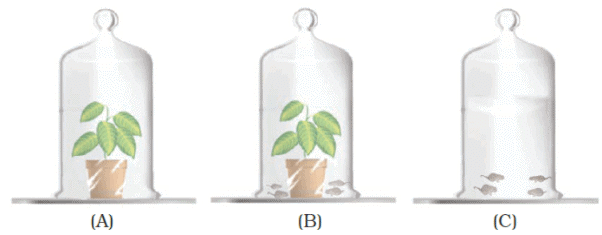
- In which jar, will the amount of CO2 be the highest and why?
- In which jar, will the amount of CO2 be the lowest and why?
Ans:
- Amount of CO2 will be the highest in jar C because mice in Jar C will breathe out CO2 which results in accumulation CO2 in the jar C.
- Amount of CO2 will be the lowest in jar A because CO2 in jar A will be utilized by plants to breathe.
Q.8. Observe Figure carefully and answer the following questions.
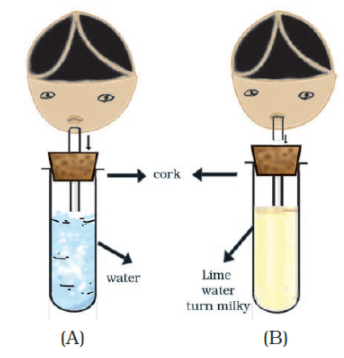
- Which process is being tested in the activity?
- What is the result of the activity? Give reasons.
Ans:
- This experiment is used to test the Exhalation process during respiration.
- Lime water turns milky in test tube B and test tube A remains unchanged because CO2 is present in the exhaled air mixes with lime water in ‘B’ and turns it milky.
Q.9. A food stall owner was preparing dough for making bhaturas. He added a pinch of yeast and sugar to the dough and left it in a warm place. After few hours, the dough had risen. There was a sour smell too.
(a) Why did the dough rise?
(b) Why did the dough smell sour?
(c) Why was sugar added to the dough?
(d) What would have happened if the dough was kept in the refrigerator, soon after it was prepared?
Ans:
a) CO2 produced by yeast during respiration makes the dough rise
b) During anaerobic respiration yeast produces alcohol. This gives sour smell to the dough.
c) Sugar acts as food for yeast
d) If kept in the refrigerator, yeast will not respire and multiply and the dough will not rise and will not produce a sour smell.
Q.10. Observe the figures given in Figure (A) and (B) and answer the following.
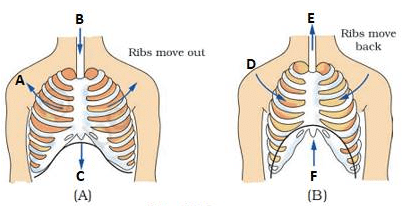
(a) Which of the figures A or B indicates the process of inhalation and which the process of exhalation?
(b) In the figure label the arrows and indicate the direction of
- movement of air
- movement of diaphragm
- movement of ribs
Ans:
a) Fig. (A) indicates inhalation, and Fig. (B) indicates exhalation.
b)
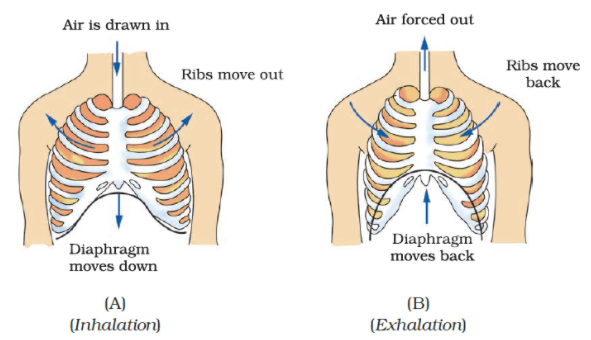
Q.11. Match the names of organisms in Column I with their organs of breathing given in Column II.
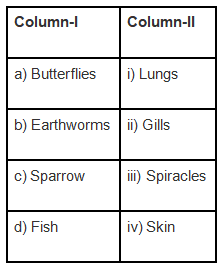
Ans:
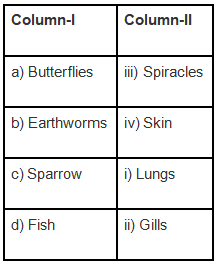
- Yeast is a single-celled organism that performs anaerobic respiration.
- During this process, it converts glucose into alcohol and carbon dioxide.
- This is crucial for producing alcoholic beverages like wine and beer.
|
111 videos|286 docs|28 tests
|
FAQs on NCERT Exemplar Solutions: Respiration in Organisms - Science Class 7 (Old NCERT)
| 1. What is respiration in organisms? |  |
| 2. How does respiration occur in organisms? |  |
| 3. What is the difference between respiration and breathing? |  |
| 4. How do organisms with different lifestyles respire? |  |
| 5. What are the types of respiration in organisms? |  |

















